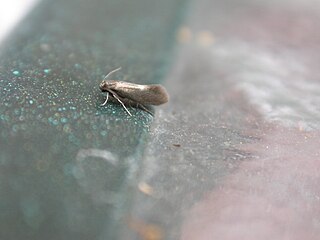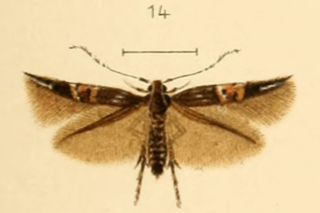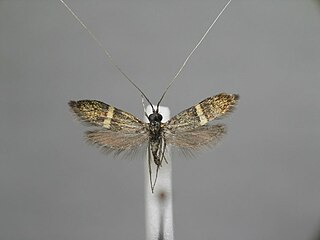| Coptodisca kalmiella | |
|---|---|
| Scientific classification | |
| Kingdom: | Animalia |
| Clade: | Euarthropoda |
| Class: | Insecta |
| Order: | Lepidoptera |
| Family: | Heliozelidae |
| Genus: | Coptodisca |
| Species: | C. kalmiella |
| Binomial name | |
| Coptodisca kalmiella Dietz, 1921 | |
Coptodisca kalmiella is a moth of the family Heliozelidae. It was described by Dietz in 1921. [1] It is found in North America, including New Jersey.

Moths comprise a group of insects related to butterflies, belonging to the order Lepidoptera. Most lepidopterans are moths, and there are thought to be approximately 160,000 species of moth, many of which have yet to be described. Most species of moth are nocturnal, but there are also crepuscular and diurnal species.

A family of primitive monotrysian moths in the order Lepidoptera, Heliozelidae are small, metallic day-flying moths with shiny smooth heads. In Europe the small adult moths are seldom noticed as they fly quite early in the spring. The larvae are leaf miners and the vacated leaf mines are distinctive because the larva leaves a large hole at the end.

North America is a continent entirely within the Northern Hemisphere and almost all within the Western Hemisphere; it is also considered by some to be a northern subcontinent of the Americas. It is bordered to the north by the Arctic Ocean, to the east by the Atlantic Ocean, to the west and south by the Pacific Ocean, and to the southeast by South America and the Caribbean Sea.
The forewings are golden-brown from the base to about the middle of the wing, passing gradually into golden yellow.
The larvae feed on Kalmia angustifolia . They mine the leaves of their host plant. The mines are irregular and blotch-like, extending from the midrib almost and sometimes entirely to the edge of the leaf. The number of mines in a single leaf varies from one to about twelve. Full-grown larvae cut an oval case from a part of the mine which is free from frass. The case containing the larva either drops to the ground or the larva crawls to the tip of a leaf pulling the case after it, and finally drops to the ground after hanging a short time suspended by a thread. Pupation takes place within the case. [2]

Kalmia angustifolia is a flowering shrub in the family Ericaceae, commonly known as sheep laurel. It is distributed in eastern North America from Ontario and Quebec south to Virginia. It grows commonly in dry habitats in the boreal forest, and may become dominant over large areas after fire or logging. Like many plant species of infertile habitats it has evergreen leaves and mycorrhizal associations with fungi. It is also found in drier area of peat bogs.

A leaf miner is the larva of an insect that lives in and eats the leaf tissue of plants. The vast majority of leaf-mining insects are moths (Lepidoptera), sawflies and flies (Diptera), though some beetles also exhibit this behavior.
Frass refers loosely to the more or less solid excreta of insects, and to certain other related matter.





